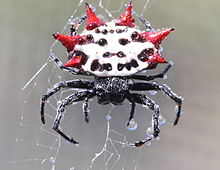Gasteracantha
| Spiny orb-weaver | |
|---|---|

| |
| G. cancriformis | |
| Scientific classification | |
| Domain: | Eukaryota |
| Kingdom: | Animalia |
| Phylum: | Arthropoda |
| Subphylum: | Chelicerata |
| Class: | Arachnida |
| Order: | Araneae |
| Infraorder: | Araneomorphae |
| Family: | Araneidae |
| Genus: | Gasteracantha Sundevall, 1833[1] |
| Species | |
|
See text. | |
Spiny orb-weavers is a common name for Gasteracantha, a genus of spiders. They are also commonly called spiny-backed orb-weavers, due to the prominent spines on their abdomen (compare genus Isoxya). These spiders can reach sizes of up to 3 cm (1.2 in) in diameter (measured from spike to spike). Although their abdomen is shaped like a crab shell with spikes, it is not to be confused with a crab spider.
Often brightly colored, spiny orb-weavers have a broad, hard abdomen that can be white, orange, or yellow with red markings.[2] The female shell is ringed by six red or orange spines, whereas the smaller male lacks the spiny projections and instead has four to five stubby dark projections.[3]

Orb-weavers' bites are generally harmless to humans.[4]

Species
As of April 2016[update], the World Spider Catalog accepted the following species:[1]
- Gasteracantha aciculata (Pocock, 1899) – New Britain
- Gasteracantha acutispina Dahl, 1914 – Sulawesi
- Gasteracantha audouini Guérin, 1838 – Sumatra, Timor, Amboina, Philippines
- Gasteracantha aureola Mi & Peng, 2013 – China
- Gasteracantha beccarii Thorell, 1877 – Sulawesi
- Gasteracantha biloba (Thorell, 1878) – Moluccas, Amboina
- Gasteracantha cancriformis (Linnaeus, 1758) (type species) – New World
- Gasteracantha clarki Emerit, 1974 – Seychelles
- Gasteracantha clavatrix (Walckenaer, 1841) – Lombok, Sulawesi, Mentawai Is.
- Gasteracantha clavigera Giebel, 1863 – Thailand, Philippines, Sulawesi
- Gasteracantha crucigera Bradley, 1877 – Malaysia, Java, Borneo, New Guinea
- Gasteracantha curvispina (Guérin, 1837) – West, Central Africa, Bioko
- Gasteracantha curvistyla Dahl, 1914 – Togian Is., near Sulawesi
- Gasteracantha cuspidata C. L. Koch, 1837 – Malaysia, Nicobar Is., Java
- Gasteracantha dalyi Pocock, 1900 – India, Pakistan
- Gasteracantha diadesmia Thorell, 1887 – India to Philippines
- Gasteracantha diardi (Lucas, 1835) – China, Thailand, Malaysia, Borneo, Sunda Is.
- Gasteracantha doriae Simon, 1877 – Singapore, Sumatra, Borneo
- Gasteracantha falcicornis Butler, 1873 – Africa
- Gasteracantha fasciata Guérin, 1838 – New Guinea, Guam
- Gasteracantha flava Nicolet, 1849 – Chile
- Gasteracantha fornicata (Fabricius, 1775) – Queensland
- Gasteracantha frontata Blackwall, 1864 – India, Myanmar, Thailand, Flores, Borneo
- Gasteracantha gambeyi Simon, 1877 – New Caledonia
- Gasteracantha geminata (Fabricius, 1798) – India, Sri Lanka
- Gasteracantha hasselti C. L. Koch, 1837 – India, China to Moluccas
- Gasteracantha hecata (Walckenaer, 1841) – Philippines
- Gasteracantha interrupta Dahl, 1914 – Lombok, Sulawesi
- Gasteracantha irradiata (Walckenaer, 1841) – Thailand to Philippines, Sulawesi
- Gasteracantha janopol Barrion & Litsinger, 1995 – Philippines
- Gasteracantha kuhli C. L. Koch, 1837 – India to Japan, Philippines
- Gasteracantha lepelletieri (Guérin, 1825) – Sumatra to Philippines, New Guinea
- Gasteracantha lunata Guérin, 1838 – Timor, Moluccas, New Caledonia
- Gasteracantha martensi Dahl, 1914 – Sumatra
- Gasteracantha mediofusca (Doleschall, 1859) – Java, New Guinea
- Gasteracantha mengei Keyserling, 1864 – Malaysia, Sumatra, Borneo
- Gasteracantha metallica (Pocock, 1898) – Solomon Is.
- Gasteracantha milvoides Butler, 1873 – Central, East, Southern Africa
- Gasteracantha notata Kulczyński, 1910 – New Britain
- Gasteracantha panisicca Butler, 1873 – Myanmar to Philippines, Java
- Gasteracantha parangdiadesmia Barrion & Litsinger, 1995 – Philippines
- Gasteracantha pentagona (Walckenaer, 1841) – New Ireland, New Britain
- Gasteracantha picta (Thorell, 1892) – Singapore
- Gasteracantha quadrispinosa O. Pickard-Cambridge, 1879 – New Guinea, Queensland
- Gasteracantha recurva Simon, 1877 – Philippines
- Gasteracantha regalis Butler, 1873 – New Hebrides
- Gasteracantha remifera Butler, 1873 – India, Sri Lanka
- Gasteracantha rhomboidea Guérin, 1838 – Mauritius
- Gasteracantha rubrospinis Guérin, 1838 – Lombok, Sulawesi, Moluccas, New Caledonia, Guam
- Gasteracantha rufithorax Simon, 1881 – Madagascar
- Gasteracantha sacerdotalis L. Koch, 1872 – New Guinea, Queensland, New Caledonia
- Gasteracantha sanguinea Dahl, 1914 – Philippines
- Gasteracantha sanguinolenta C. L. Koch, 1844 – Africa, São Tomé, Yemen, Seychelles, Socotra
- Gasteracantha sapperi Dahl, 1914 – New Guinea
- Gasteracantha sauteri Dahl, 1914 – China, Taiwan
- Gasteracantha scintillans Butler, 1873 – Solomon Is.
- Gasteracantha signifera Pocock, 1898 – Solomon Is.
- Gasteracantha simoni O. Pickard-Cambridge, 1879 – Central Africa
- Gasteracantha sororna Butler, 1873 – India
- Gasteracantha sturi (Doleschall, 1857) – Laos, Sumatra, Java, Borneo, Moluccas
- Gasteracantha subaequispina Dahl, 1914 – Borneo, New Guinea
- Gasteracantha taeniata (Walckenaer, 1841) – India to Polynesia
- Gasteracantha theisi Guérin, 1838 – New Guinea, Moluccas
- Gasteracantha thomasinsulae Archer, 1951 – São Tomé
- Gasteracantha thorelli Keyserling, 1864 – Madagascar
- Gasteracantha tondanae Pocock, 1897 – Sulawesi
- Gasteracantha transversa C. L. Koch, 1837 – Sumatra, Java
- Gasteracantha unguifera Simon, 1889 – China, India
- Gasteracantha versicolor (Walckenaer, 1841) – Central, East, Southern Africa
- Gasteracantha westringi Keyserling, 1864 – Australia, Admiralty Is., New Caledonia
See also
References
- ^ a b c "Gen. Gasteracantha Sundevall, 1833", World Spider Catalog, Natural History Museum Bern, retrieved 2016-04-22
- ^ "Beneficial spiders in the landscape: #23 Spiny Orb Weaver Spider". aggie-horticulture.tamu.edu. Beneficials in the Garden & Landscape.
- ^ Weber, Lynne; Weber, Jim (2011). Nature Watch Austin: Guide to the Seasons in an Urban Wildland. Amazon Digital Services LLC: Texas A&M University Press. p. 128.
- ^ "Urban Spider Chart".
